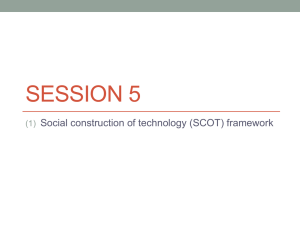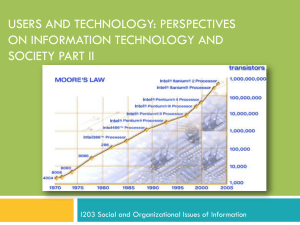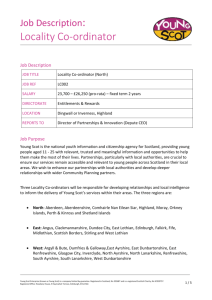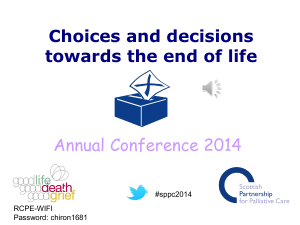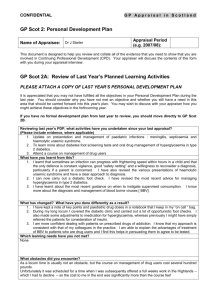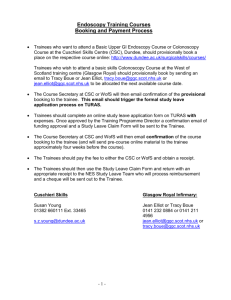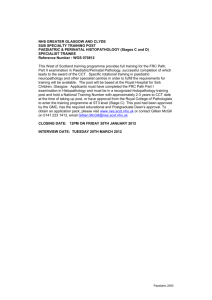9.g Translations of Risks Associated with the Use of Recordable
advertisement
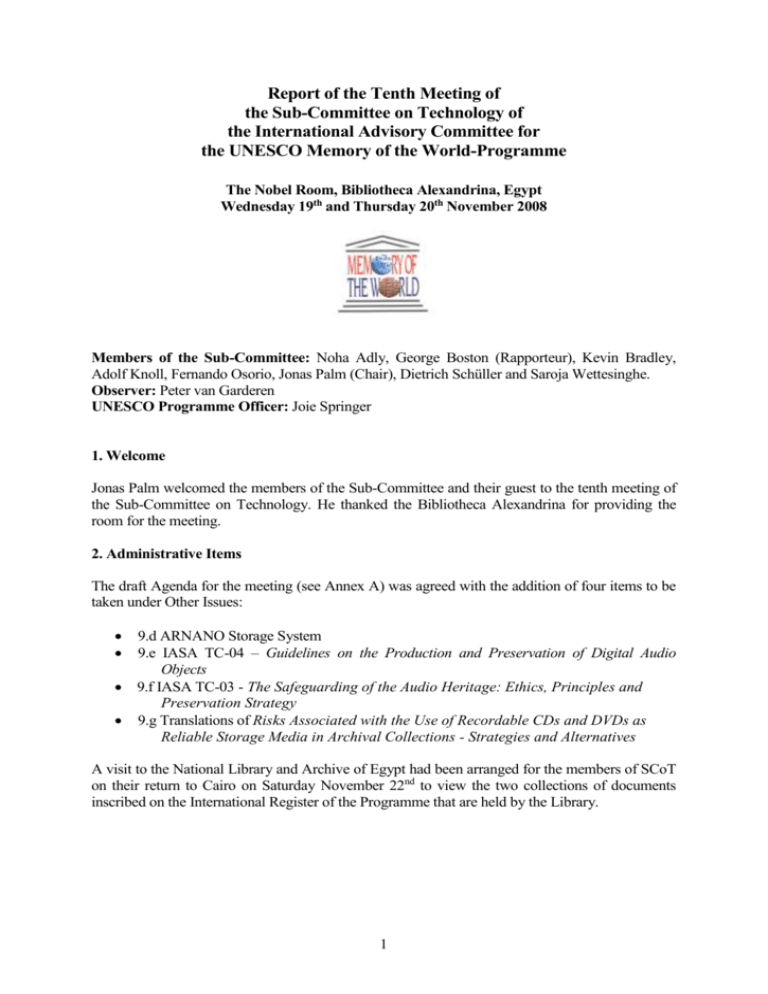
Report of the Tenth Meeting of the Sub-Committee on Technology of the International Advisory Committee for the UNESCO Memory of the World-Programme The Nobel Room, Bibliotheca Alexandrina, Egypt Wednesday 19th and Thursday 20th November 2008 Members of the Sub-Committee: Noha Adly, George Boston (Rapporteur), Kevin Bradley, Adolf Knoll, Fernando Osorio, Jonas Palm (Chair), Dietrich Schüller and Saroja Wettesinghe. Observer: Peter van Garderen UNESCO Programme Officer: Joie Springer 1. Welcome Jonas Palm welcomed the members of the Sub-Committee and their guest to the tenth meeting of the Sub-Committee on Technology. He thanked the Bibliotheca Alexandrina for providing the room for the meeting. 2. Administrative Items The draft Agenda for the meeting (see Annex A) was agreed with the addition of four items to be taken under Other Issues: 9.d ARNANO Storage System 9.e IASA TC-04 – Guidelines on the Production and Preservation of Digital Audio Objects 9.f IASA TC-03 - The Safeguarding of the Audio Heritage: Ethics, Principles and Preservation Strategy 9.g Translations of Risks Associated with the Use of Recordable CDs and DVDs as Reliable Storage Media in Archival Collections - Strategies and Alternatives A visit to the National Library and Archive of Egypt had been arranged for the members of SCoT on their return to Cairo on Saturday November 22nd to view the two collections of documents inscribed on the International Register of the Programme that are held by the Library. 1 3. Membership of SCoT Joie Springer said that, under the Statutes for the SCoT adopted in Mexico in 2006 (see Annex C), the term of office of George Boston, Adolf Knoll, Fernando Osorio and Dietrich Schüller was drawing to a close. Their appointments were able to be renewed if the SCoT agreed and the individuals were willing to continue as members of the Sub-Committee. In a short debate, George Boston drew attention to the fact that, if his term was renewed, he would be seventy years old when it expired. Dietrich Schüller also had some reservations about continuing for a further term. Adolf Knoll and Fernando Osorio were willing to be considered for an additional term on the Sub-Committee. The conclusion reached was that all four people due to retire from office would be invited to continue to serve on the Sub-Committee. 4. Report of the Last Meeting The Report of the last meeting held in Mexico City in 2006 was accepted as a true record of events. 5. The Information for All Programme (IFAP) Dietrich Schüller said that the Inter-Governmental Council for IFAP was made up of representatives of twenty six member states elected by the biennial General Assembly of UNESCO. He reported that the Executive Council of UNESCO had recently adopted a revised Strategy Plan of IFAP. This set up five working groups. One of these affected the relationship of IFAP with SCoT – the Working Group on Information Preservation. A copy of Priority: Information Preservation - the proposed aims for the Working Group and possible partners is given in Annex D (Part 1). A longer draft statement for terms of reference for the Working Group is given in Annex D (Part 2). Dietrich Schüller continued by suggesting that the proposed Working Group would have as its core the members of SCoT. Representatives of the relevant NGOs and of industry would also be included. George Boston said that there was a danger that the new body would duplicate the activities of SCoT and thereby waste scarce resources. He added that the NGOs are already represented in SCoT albeit not as of right. Dietrich Schüller replied that he had fought for this solution to ensure that the new Working Group did not duplicate the work of SCoT. The role of the NGO representatives would be to provide a strategic view of the needs of archives and libraries. The representatives would have to reflect the international community as a whole to create a list of the concerns of libraries and archives worldwide. The SCoT would continue to be the body of preservation experts that provided answers that help meet those concerns. The members of SCoT had, therefore, to be chosen for their expertise. Joie Springer said that IFAP was being positioned as the umbrella body for information management. The Memory of the World Programme is, however, autonomous and reports directly to the Director-General. George Boston asked about the practicalities of the relationship between SCoT and the IFAP 2 Working Group. Joie Springer replied that it was probable that the IFAP Working Group would draft a list of current problems some three to six months before a meeting of the SCoT. This would give time for the members of SCoT to discuss the topics by electronic communications in preparation for the meeting. Dietrich Schüller said that preservation and access were rather dwarfed by the Memory of the World Registers. The SCoT was the only part of the Programme that concentrated on the core reasons for the Programme. George Boston added that the primary role of the Memory of the World Programme was to improve preservation of and access to the documentary heritage of the world. There was no boundary to this work. The technical problems uncovered defined the work of the SCoT. Saroja Wettesinghe said that any solutions offered had to be tailored to the capabilities of less advanced countries. Fernando Osorio said that there was some overlap in the work of IFAP and the Memory of the World Programme particularly in the area of raising awareness of the endangered documentary heritage. Adolf Knoll asked if the SCoT would be a member or the core of the IFAP Working Group. Dietrich Schüller replied that the SCoT would, effectively, be the core of the new body. Kevin Bradley asked if the SCoT could enlist the help of new members for particular problems. George Boston replied that the Statutes for the Sub-Committee permitted the co-option of temporary members. He added that the Memory of the World Programme is independent of IFAP; IFAP is kept informed of the work of the various Memory of the World bodies as a courtesy not a right. Dietrich Schüller said that the IFAP Working Group should be kept as small as possible. It should also conduct as much of its business by electronic means as is practical. The need for meetings could not be ruled out, however. He expressed concern that the main NGOs working in the field – ICA, IFLA and CCAAA – were seen as being European. The new UNESCO restrictions on using “European” organisations might well hamper their activities in support of UNESCO. Joie Springer said that the membership of SCoT already included people from the main NGOs. A pragmatic solution would be to seek endorsement of the present members from their NGOs. Dietrich Schüller said that there was a need to recruit representatives of industry. Joie Springer replied that UNESCO already has agreements with some companies. The scope of these agreements could be extended to include preservation topics where appropriate. Others companies including Sony and Google are actively seeking to reach similar agreements. Kevin Bradley and Dietrich Schüller said that the Open Source community must also be involved. Noha Adly said that work for UNESCO must, by definition, be Open Source. This particularly important if the work was sparked by an idea from a UNESCO committee. Peter van Garderen added that the use of the Open Source concept avoided difficulties with people saying “Why that vendor and not this one?”. Dietrich Schüller said that the private sector naturally tries to impose a closed system on its customers. IFAP proclaims the benefits of Open Source software. He added that the Chair of SCoT could be the Chair of the Working Group as well. Joie Springer said that there is a statement about Free and Open Source Software in the IFAP Strategic Plan (See Annex D (Part 3)). 3 6. Action Points from Mexico Meeting (see Annex E) AP 1 – The sample contracts have been circulated by Adolf Knoll. AP 2 – The questions for the nominators of the Yemeni project proposal were supplied. AP 3 – The draft Executive Summary for Risks associated with the Use of Recordable CDs and DVDs was written and circulated. AP4 – A skeleton draft of the long term storage document had been written (see Annex H). The relevance of the text was debated. Saroja Wettesinghe considered it to be a very useful text; Dietrich Schüller was sceptical about the usefulness of providing information about standards. Evidence from a number of institutions was that there was a great danger in the standards being applied without thought to the detriment of the documents in store. He considered that, if the text was to be issued, it should point to problem areas but not offer firm answers. The SCoT agreed to set-up a Working Group to take the text forward. Jonas Palm, Saroja Wettesinghe, Fernando Osorio and Noha Adly agreed to form the Group. AP 5 and 6 – Both tasks were completed. AP 7 – This would be the subject of the Special Session after the routine business of SCoT was concluded. 7. Questionnaire to Establish Level of Success of Programme Jonas Palm began the discussion by saying that the level of success that the Programme was having in improving the standard of preservation of and access to documents was uncertain. It was proposed that a questionnaire be circulated to institutions with documents inscribed on the International Register to seek information about how the inscription had changed the condition of the collection. Noha Adly asked why the Registers existed. Joie Springer replied that the Registers at the National, Regional and International levels provided opportunities to gain publicity for collections. She added that publicity was not required to make professionals in the field aware of the importance of the various collections but, through publicity, public interest would be stirred, leading to greater interest in the documents and, in turn, greater willingness by governments to fund the upkeep of the collections. Inscription did not mean that UNESCO would finance the work of preserving the documents. Part of the nomination form asked for details of the level of funding available for preserving the documents nominated. A questionnaire was proposed as being the best way to gain information about the effectiveness of inscription of documents on the Registers. George Boston said that there were three key questions that should be answered – changes in the management of the collection; an assessment of changes in the risk to the documents; and changes in the preservation conditions for the documents. Additional questions might include topics such as the change in visitor numbers and changes in contact details for the custodians. Kevin Bradley said that the receipt of yet another survey form would cause much eye-rolling by custodians. The questions in the survey form should be worded so that existing information can be used rather than requiring additional work to answer the questions. George Boston replied by saying that the questions would only be about the inscribed documents and would be concerned with the changes, if any, that inscription has caused. 4 Kevin Bradley said that the survey should not be used to create a “standard” management system that covered all inscribed documents. Neither should custodians be required to carry out a full risk assessment of their collections. Dietrich Schüller said that the survey should seek to establish how inscription has changed the level of awareness in the public about the collections. Did the publicity at the time of inscription help? This – not the condition of the documents - was a better fact to discover. Kevin Bradley said that the management plan had to be declared on the nomination form. Information about how it had developed and whether it had worked as intended would be useful to help guide others. The meeting agreed upon a draft to be edited by Joie Springer to meet the layout required by UNESCO. 8. “Preserving our Documentary Heritage" – Inclusion of more information about nonwestern materials Saroja Wettesinghe said that the electronic booklet "Preserving our Documentary Heritage" that was produced by the SCoT in 2005 lacked information about textual carriers such as palm leaves, papyrus and tree barks. She asked if the booklet could include some extra information covering these types of carriers. The SCoT agreed that this would be possible – indeed desirable. In addition to a few sentences in the present publication, there may be a need for a longer, more detailed publication to help custodians who may have only a few of these categories of document within a larger paper-based collection. It was agreed that Saroja Wettesinghe would write a few sentences about palm leaves; Kevin Bradley would seek an expert on tree barks at the Australian Institute of Aboriginal and Torres Straits Islander Studies; and Noha Adly would seek an expert on papyrus at the Bibliotheca Alexandrina. Jonas Palm asked if it would be possible for the new edition to include some pictures to make the document more interesting. He said that the references would also require updating. Joie Springer said that in recent years, nominators of documents for inscription on the International Register had been asked to agree that images of the documents could be used by UNESCO to publicise the Memory of the World Programme. George Boston said that he done some work to add pictures to the exiting text. He agreed to complete this work and to circulate it to the members of SCoT to give an idea how the revised edition could look. The position of rock and stone inscriptions within the Programme was questioned. Joie Springer said that several inscriptions had been inscribed on the International Register. The basic requirement was that information was being recorded. Some paintings and similar nontextual works might meet the requirement of preserving information. For example, the Bayeux Tapestry had been inscribed in 2007. As the area between an image as a work of art and an image as an information carrier was not precisely defined, each case would have to be considered on its merits. Jonas Palm reminded the SCoT that it was not the Sub-Committee’s job to write texts to cover all types of material. The role of SCoT was to draw attention to the better existing texts, to look for gaps in the available literature and to seek to fill those gaps either by commissioned work or by writing the text themselves. 5 It was agreed that the revised edition should be available in the UNESCO languages on the website and that some hard copies be printed to meet the needs of places with difficulty accessing the web. Numbers to be printed would be around 150 in English, 50 in French, 75 in Spanish and 25 in Arabic. Several members of SCoT agreed to get estimates for the cost of printing. It was noted that translations would be a major cost and that suitable volunteers would be sought to assist with the work and thereby keep costs low. Alternative publishing formats e.g. as a poster which could be folded, would be investigated by Jonas Palm. A deadline for the writing of the additional sentences on non-Western carriers and completion of the first draft was set at March 1st 2009. George Boston agreed to be the editor for the project. Saroja Wettesinghe said that she would organise a survey of institutions holding palm leaves, papyrus and tree bark documents to seek a consensus on best practice for these carriers. 9. Other issues a. The Jikji Prize. Joie Springer reported that the General Council had asked that the rules for prizes awarded under the aegis of UNESCO be harmonised. Negotiations were in progress with the Republic of Korea about modifying the Statutes for the Jijki Prize. Until these negotiations were completed, no call for nominations would be made. Dietrich Schüller said that his institution, the Austrian Academy of Sciences, had been proud to have been the winner of the second Jijki Prize in 2007. The Phonogrammarchiv had, however, decided to give the money to the University of the Philippines to assist with a project to digitise an audio collection. A memorandum of understanding had been agreed between the Academy Phonogrammarchiv and the University that required the University to find matching funds and for the Phonogrammarchiv to provide training in Vienna for two technicians. The Phonogrammarchiv had asked that all the money be sent to Manila apart from the funds needed to buy to tape machines for the project. b. New Nominations for the International Register. The External Assessor for the nomination of the United Nations Relief and Works Agency for Palestine Refugees in the Near East (UNWRA) had asked that the opinion of SCoT be sought about the technical aspects of the proposal (see Annex F – Part 1: the Nomination Form; Part 2: the External Assessor’s Assessment). The Assessor referred to a report on the images by the Institut National de l’Audiovisuel (INA) in Paris. This was not included in the papers supplied. Based on the information provided, Fernando Osorio said that the copying of the video material seemed to be the most urgent task because of the increasing problems caused by the obsolescence of the formats. Dietrich Schüller said that it would be best to store the digitised images in a mass store. It was likely that INA had recommended the use of a digital compressed production format. To use a production format would only require the material to be copied again later. The production format may also use a lossy compression system that would greatly endanger the future quality of the images. He referred to the DOXA Archive project of 2007 saying that the UNWRA proposal had many similarities to the DOXA one (see Annex F – Part 3). Joie 6 Springer said that she would try to obtain a copy of the INA report. However, the report was only available in French. George Boston said that it was clear that the video tape material had to be given priority. Although some of the film and still images were in poor condition, they were stored in a cold vault in Amman and were, therefore, unlikely to become dramatically more decayed in the short term. The photographic still and moving images would require careful inspection to determine the restoration that each would require to make them suitable for copying. Two people within SCoT have the skill for this work – Jonas Palm and Fernando Osorio. c. Training for Archive and Library Technicians SCoT had held a Joint Meeting with the Technical Committee of IASA in Mexico City in September 2006 to discuss training of technical staff for libraries and archives. This had generated some ideas about ways of providing training materials to those requiring them. A number of initiatives were being discussed at various levels but no clear opinion had yet evolved. Dietrich Schüller said that the Co-ordinating Committee for the Audiovisual Archive Associations (CCAAA) has increasingly been pressing the need for more training for archive and library technicians in the AV field. The International Association of Sound and Audiovisual Archives (IASA), in particular, has been supporting workshops and seminars aimed at improving standards of archive technicians. Kevin Bradley said that he and Ray Edmondson had tried to set up a workshop for the Pacific region with support from the International Center for Renovation and Maintenance of Cultural Heritage Sites (ICCROM). This had failed because of a drop in budgets. Dietrich Schüller said that the IASA Training and Education Committee was working to codify some of the existing workshop material. The project would also identify core competency levels to enable training material to be produced that guides students along a series of graded steps. Saroja Wettesinghe said that there was a need for training in the preservation of the Asian and Indian text carriers such as palm leaves. People are working in isolation and there is no forum for the exchange of ideas to help develop an idea of best practice. Joie Springer said that UNESCO did not have a specific budget for training. Help with training initiatives was offered when money was available. George Boston suggested a regional seminar for technicians. Jonas Palm said that it was difficult to get technicians to attend such events. Managers tended to highjack the places. Dietrich Schüller said that a colleague, Albrecht Häfner, had experience of providing training in sound archives in Asia. He had reported that, in addition to the training of archive staff, training for the directors and managers of archives was necessary to improve their understanding of the needs and capabilities of conservators. It would be more effective to change the agenda from concentrating on training the people performing the technical tasks to making their managers and directors aware of the problems that needed to be overcome by means of a “horror” film showing examples of various forms of decay. Jonas Palm asked if IFAP would support initiatives to improve training. Joie Springer 7 mentioned the CCAAA initiative to organize a Joint Management Symposium which has so far failed to be implemented. Kevin Bradley said that, as the new President of IASA, he would be working to make the CCAAA more effective in this area. His predecessor as President of IASA, Richard Green of the Archives and Libraries of Canada, was very keen on education for managers. He added that the ICROM project had included a major strand of training for managers. Saroja Wettesinghe said that language difficulties may make it difficult for junior staff to take full advantage of training opportunities. Hands-on training with competent interpreters was the best method. Training should be organised on a regional basis. On-line training packages could be particularly helpful as it would mean that staff could receive training at their own establishment thus saving the costs of travelling etc. Dietrich Schüller said that the TAPE project (Training for Audiovisual Preservation in Europe) funded by the European Commission had produced a number of useful web-based training aids for audio technicians as well as more traditional workshops. Now that the European Commission for Preservation and Access (ECPA) which had coordinated the TAPE project had been closed down, the web-based material had been re-located to the web-site of the Austrian Academy of Sciences. The address for these training materials was http://www.tape-online.net/ Dietrich Schüller continued by recommending a workflow package for the digitisation of audio tapes. This was aimed at non-technical staff and can be found on the TAPE website. He took this opportunity to express thanks to the staff of ECPA for the work that they had done to aid the preservation of information materials. He reminded the members of the SubCommittee that ECPA had hosted the meeting held in Amsterdam in 2005. Kevin Bradley said that it would be helpful to prepare packages of training material that could swiftly take advantage of opportunities as they arose. George Boston said that short training videos would also be helpful, particularly for the demonstration of practical restoration techniques. Joie Springer said that the UNESCO website has an on-line training platform (http://opentraining.unesco-ci.org/cgi-bin/page.cgi?g=;d=1 ). Perhaps the platform could hold a Memory of the World sub-section. d. ARNANO Joie Springer had asked the members of SCoT to examine an alternative to microfilm that etched pages on to glass using a laser (see Annex G). The members of SCoT considered that the extra costs of the process were not justified by the increased ruggedness of the product. Neither did it offer greater data density than possible with microfilm. It was considered an interesting but impractical solution. e. IASA TC-04 – Guidelines on the Production and Preservation of Digital Audio Objects Kevin Bradley reported that a second edition of this publication was about to be issued. It was a larger and better structured version of the original issued in 2004. He asked if the SCoT would repeat the endorsement that had been given to the first edition. The SCoT agreed to the book carrying the endorsement of the Memory of the World Programme. 8 f. IASA TC-03 - The Safeguarding of the Audio Heritage: Ethics, Principles and Preservation Strategy Dietrich Schüller reported that the third edition of this publication was now available on the IASA website in six languages in addition to the original English – French, German, Italian, Russian, Spanish and Swedish. g. Translations of Risks Associated with the Use of Recordable CDs and DVDs as Reliable Storage Media in Archival Collections - Strategies and Alternatives Jonas Palm asked if the SCoT still considered this publication relevant. Did it require updating? Should it be updated? The Sub-Committee felt that, on balance, it was still useful. Joie Springer agreed to investigate translating it into French. 10. Closure of the Meeting Saroja Wettesinghe invited the members of SCoT to hold their next meeting Colombo, Sri Lanka. This was accepted by the members of the Sub-Committee and a provisional date of November 2010 was agreed. In closing the meeting, Jonas Palm, on behalf of his colleagues, thanked Noha Adly and her colleagues for the excellent facilities provided and the generous welcome that the SCoT had received. George Boston added his particular thanks to the administrative team who had worked hard to make all the arrangements for the meeting and to overcome several unexpected difficulties. 9
